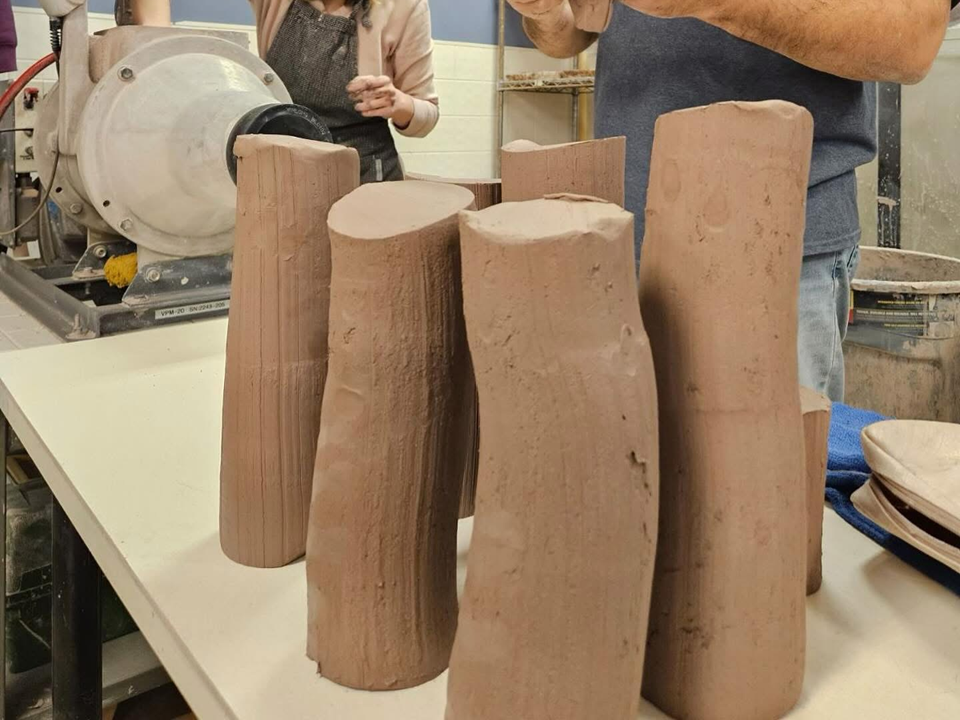Clay Care = Community Care: A Shared Commitment to Recycling

Clay Care = Community Care: A Shared Commitment to Recycling
In our studio, clay isn’t just a material—it’s a shared resource, shaped by many hands and sustained by collective care. Every bit of clay we reuse is one less pound we need to buy, one less strain on our reclaim system, and one more way we honor the earth and each other.
It’s easy to toss wet scraps into a bin or leave a puddle of slurry behind—but small habits add up. By taking a few mindful moments at the end of each session, we keep our studio flowing smoothly, sustainably, and respectfully for everyone.
Here’s how we can all help:
Use Water Wisely
When throwing, water is for *lubrication*—not softening. Too much water weakens the clay, leading to slumping or collapse. A damp sponge or a few light squirts are plenty. Less water = stronger forms *and* less slurry to manage later.
Dry Scraps on Plaster Bats—Not the Wedging Table
We’ve placed plaster bats at each wheel station for a reason! Press your wet scraps onto them to start the drying process. Flip them after 15–20 minutes so both sides dry evenly. Once leather-hard, wedge the clay and return it to a labeled bag for reuse.
*Please don’t dry scraps on the wedging table*—it blocks space for others and slows down shared workflow.
No Wet Clay in Plastic Bags
Wet clay sealed in a bag won’t dry—it’ll just turn into a smelly, unusable lump and risk contaminating other clay. If it’s still too wet to wedge, leave it on the plaster bat. It’ll be ready soon!
Recycle Thoughtfully
We have two dedicated recycling stations to keep things efficient:
- Dry Bin (black container under the pug mill): For bone-dry scraps, trimmings, or clay too dry to wedge. To help it break down faster, flatten scraps into disks or slice them—no solid balls or thick chunks! Large pieces take forever to dry and clog the system.
- Slurry Bin (with metal mesh strainer):
- For watery clay residue and tiny wet scraps. Always pour through the mesh to catch sponges, tools, or hair ties—non-clay items can damage the pug mill.
*Please avoid putting large wet chunks (bigger than a golf ball) into either bin.* Those can be reclaimed through wedging once dried slightly!
Leave Your Space as You’d Like to Find It
At the end of your session—whether it’s a class, open studio, or private time—please:
- Re-wedge and bag any reusable clay
- Wipe down your table
- Rinse tools and return them
- Sweep your floor area
- Empty your water bucket into the slurry bin (through the strainer!)
This isn’t just “cleaning up”—it’s making space for the next maker to step in with ease and inspiration.
Together, We Keep This Studio Alive
Every time you flatten a scrap, wedge reclaimed clay, or rinse your sponge mindfully, you’re doing more than saving clay—you’re tending to our shared creative home.
Thank you for your care, your attention, and your commitment to this community. With your help, our studio stays sustainable, welcoming, and full of possibility—for today’s makers and tomorrow’s.
*With gratitude,
Your Studio Community*
Customer Testimonials
Our participants share their experiences—many discover not just pottery, but a creative community.






